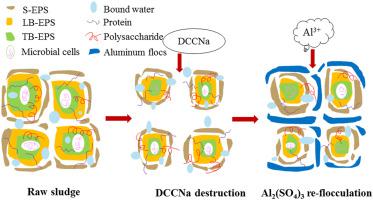Journal of Environmental Management ( IF 8.0 ) Pub Date : 2021-01-25 , DOI: 10.1016/j.jenvman.2021.112020 Yanting Dong , Yanwen Shen , Dongdong Ge , Chang Bian , Haiping Yuan , Nanwen Zhu

|
Sludge dewatering is necessary to reduce the volume of sludge for cost-effective transport and ultimate disposal. In this study, a novel combined chemical conditioning process was proposed to improve sludge dewatering performance in which sludge flocs were destructed by sodium dichloroisocyanurate (DCCNa) and re-flocculated by Al2(SO4)3 and the mechanism was elucidated. The results showed that sludge capillary suction time (CST) dropped to 15.4 s and moisture content of dewatered sludge cake (Mc) deceased to 71.01% respectively, after the application of combined conditioning with the optimal dosage of 200 mg DCCNa/g dry solids (DS) and 80 mg Al2(SO4)3/g DS. With chemical conditioning, sludge physicochemical properties were greatly changed. With the DCCNa application, the percentage of low-molecular-weight substances in soluble extracellular polymeric substances (S-EPS) increased. Also, the sludge zeta potential dropped from −16.85 mV to −25.45 mV and the median particle size (D50) decreased from 54.1 μm to 51.6 μm. However, the subsequent conditioning by Al2(SO4)3 dosing not only led to an increment of 18% in the portion of macromolecules in S-EPS, but also increased the zeta potential and D50 to −10.74 mV and 53.2 μm, respectively. The bound water content in sludge declined from 2.92 g/g DS to 1.98 g/g DS after combined conditioning. We concluded that DCCNa disintegrated the sludge flocs and microbial cells leading to the release of bound water, fine particles and organic substances with negative charge, and the fine colloidal particles can be flocculated into large dense aggregations with the dosing of Al2(SO4)3. In summary, the proposed combined conditioning provided a highly effective and environmental friendly approach to improve the sludge dewatering performance.
中文翻译:

基于二氯异氰脲酸钠的调节工艺以改善污泥的脱水性和机理研究
污泥脱水对于减少污泥的体积是必要的,以便进行具有成本效益的运输和最终处置。在这项研究中,提出了一种新颖的联合化学处理工艺来提高污泥脱水性能,其中污泥絮凝物被二氯异氰脲酸钠(DCCNa)破坏并被Al 2(SO 4)3再次絮凝,并阐明了机理。结果表明,最佳组合剂量为200 mg DCCNa / g干固体后,联合处理后,污泥毛细抽吸时间(CST)下降至15.4 s,脱水污泥饼(Mc)的含水量分别下降至71.01%( DS)和80 mg Al 2(SO 4)3/ g DS。通过化学调节,污泥的理化性质发生了很大变化。随着DCCNa的应用,可溶性细胞外聚合物(S-EPS)中低分子量物质的百分比增加了。另外,污泥ζ电位从-16.85mV下降至-25.45mV,中值粒径(D50)从54.1μm下降至51.6μm。然而,随后通过Al 2(SO 4)3进行调节给药不仅导致S-EPS中的大分子部分增加18%,而且还将zeta电位和D50分别提高至-10.74 mV和53.2μm。综合处理后,污泥中的结合水含量从2.92 g / g DS降至1.98 g / g DS。我们得出的结论是,DCCNa分解了污泥絮凝物和微生物细胞,从而释放了结合的水,带负电荷的细小颗粒和有机物质,并且细微的胶体颗粒可以通过投配Al 2(SO 4)絮凝成大的密集聚集体。3。总而言之,所提出的组合调节提供了一种高效且环保的方法来改善污泥的脱水性能。











































 京公网安备 11010802027423号
京公网安备 11010802027423号